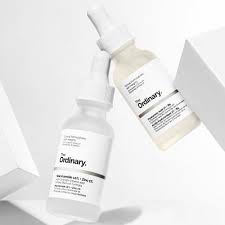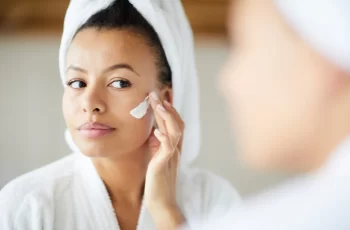Can I Use Hyaluronic Acid and Niacinamide Together?
When it comes to skincare ingredients, it must be said that two skin heroes are indeed, hyaluronic acid and niacinamide. But the question we have is whether these powerhouses can be used together? That is exactly what we are planning to answer today, so let’s dive right in and find out more.
What is Niacinamide?
Niacinamide is a form of vitamin B3 and provides impressive hydrating benefits for the skin. It can do this with the humectant properties it contains ensuring that water surrounding the skin and present in product formulas are locked into the skin keeping it fully hydrated and plumped. Another unique trait of niacinamide is its ability to regulate the sebum production making it a great ingredient for those who suffer from blemish-prone skin types.
What is Hyaluronic Acid?
Hyaluronic acid is another ingredient that provides impressive humectant benefits for the skin. By ensuring the skin is fully hydrated with the protective skin barrier strengthened and able to protect itself from exposure to free radical damage, such as UV rays, pollution, and environmental aggressors. You will also find that signs of dehydration are reduced leaving the complexion looking bright, vibrant and line free.
Now you have had a little refresher course on each of those ingredients, let’s investigate together more about using them together in your routine.
Can hyaluronic acid be used with niacinamide?
Yes, you can! Both hyaluronic acid and niacinamide can be used together, they are both water-based ingredients and are highly effective at ensuring the skin remains plumped and hydrated. When using these ingredients together it is considered to firstly apply hyaluronic acid to rejuvenate the skin and lock moisture into place, following this with niacinamide will also ensure the sebum production is regulated. You can find out more about using hyaluronic acid and niacinamide together over on our dedicated blog post.
What should you not mix with hyaluronic acid?
Unsurprisingly there are little to no ingredients that can’t be mixed with hyaluronic acid. Due to the fact it is suitable for all skin types as well as the ability to be teamed with other ingredients, including those known for being highly potent, such as retinol, salicylic acid, and glycolic acid. In fact, you’ll find these ingredients benefit from hyaluronic acid as a way of reducing any potential flare-up in dryness and irritation to the skin which is often caused by the exfoliating properties of the mentioned acids.
Do you use niacinamide before or after hyaluronic acid?
As I have already mentioned, when using both hyaluronic acid and niacinamide together it is considered best to apply hyaluronic acid first, to give a boost in hydration, followed by niacinamide to regulate sebum production. Alternatively, if you can apply hyaluronic acid enriched serum during your morning routine to keep the skin barrier strengthened and functioning properly. You can then follow this with niacinamide during your evening routine to rejuvenate and repair the skin. Whilst combating any skin damage caused from exposure to free radicals, such a pollution and UVB/UVA rays.
Which is better hyaluronic acid or niacinamide?
Both of these powerhouse ingredients are highly effective at improving the overall look and feel of the skin. Considering your skin type may help you decide which is better, due to the unique benefits of niacinamide of regulating oil in the skin making it a beneficial ingredient to use if you are prone to oiliness and suffer with frequent breakouts. The beauty of hyaluronic acid as I have already mentioned is its ability to be used with all skincare products and skin types. Of course, there is nothing stopping you from using both ingredients together to help retain moisture keeping complexions looking brighter, plumper, and smoother.
Can I use niacinamide every day?
You can indeed, in fact, it is known for being well tolerated by most people often resulting in them using it twice a day. You’ll find that you really reap the rewards of its hydrating benefits during the winter months by combating exposure to harsh climates and central heating. By using niacinamide twice a day you’ll also find that applying more potent ingredients, such as retinol and glycolic acid, you’ll be able to combat the common drying effects leaving you with vibrant, healthy skin that’s full of bounce.
Can I use hyaluronic acid every day?
Absolutely! Much like niacinamide you’ll find you are able to use it twice a day. There are a few pointers to remember when getting the best out of your hyaluronic acid enriched products. To get the most out of your hyaluronic acid products its best to apply them in the correct order starting with the thinnest consistency making your way up to the thickest. Therefore, you should apply hyaluronic acid before your moisturiser and SPF as these formulas are too thick and often create a physical barrier on the skin surface. For optimal results, apply hyaluronic acid to cleansed skin that is still damp enabling the humectant traits of HA to lock the moisture into the protective skin barrier.
Is niacinamide good for acne or hyaluronic acid?
Although both powerhouses are effective and beneficial for acne prone skin, if you were to twist my arm, I’d suggest trying niacinamide. This is because the unique benefit of niacinamide having the ability to regulate the sebum production in the skin. This allows your skin to remain balanced with any signs of frequent breakouts being combated and reduced.
This doesn’t however result in hyaluronic acid not being as effective on acne or blemish-prone skin. Quite often those who have an oily or blemish-prone skin use skin ingredients such as salicylic acid, benzoyl peroxide and retinol, all of which are very effective, but tend to feel quite drying to the skin. This is when the hydrating benefits of hyaluronic acid can counteract this and keep the complexion plumped, moisturised, and healthy whilst the other ingredients work at targeting breakouts and blemishes.
I hope that I’ve managed to answer some of your questions you have about using niacinamide and hyaluronic acid together. Don’t forget to come and follow us on Instagram for more!
DQH Knowledge drop: In your 20s, your skin cell turnover decreases. (Cell turnover is a key component in keeping your skin youthful.) You know what else slows down? Your collagen production. Starting in your 20s, collagen decreases by about 1 percent per year. Should you want to prevent fine lines and wrinkles, start by eliminating behaviors that contribute to premature aging. “If it’s bad for you, it’s bad for your skin,” says dermatologist Michel Somenek.
“Cigarette smoking reduces blood flow to the skin and causes premature wrinkling and a dull skin texture. Making the repeated pursed motion to inhale can also cause smoker’s lines. Alcohol and recreational drugs are toxins for the skin that damage its cellular structure and DNA,” Somenek tells us. “The faster you eliminate vices while you are young, the better chance your skin and body have to recuperate.” Also, adopting an anti-aging routine in your 20s is key. After all, the best offense is a good defense. We spoke to Somenek and experts Joshua Ross and Audrey Kunin to find out more.
Keep reading for the best anti-aging products for your 20s, according to skincare professionals.
Sunscreen
“We all know that the sun is the number one cause of skin aging and starting the prevention in your 20s is very important,” Ross says. “The majority of your sun damage won’t start to appear until you’re in your 30s, so don’t wait until you see it surface or you’ll be behind the curve. Stay ahead of it with a good-quality zinc-based sunscreen worn daily.”
Farmacy Green Defense Daily Mineral Sunscreen
An invisible sunscreen with SPF 30, plus botanical extracts meant to protect skin with tons of antioxidants. Bonus: It’s clean and fine to use under makeup.
Bareminerals Complexion Rescue™ Tinted Moisturizer Broad Spectrum SPF 30
Although we recommend you use your SPF and moisturizer separately, we also understand moments when you don’t have time or energy for that extra step. For those times, this bareMinerals moisturizer is a great thing to have on hand.
Vitamin C Serum
“A great introduction to anti-aging is to start with a vitamin C serum in your morning skincare routine,” Ross says. “It’s a powerful antioxidant that will neutralize free radicals and brighten the skin.” He adds that it’s a great way to counteract the effects of the sun’s harmful rays, which, as previously mentioned, are among the biggest causes of premature aging.
Drunk Elephant C-Firma™ Vitamin C Day Serum
The Drunk Elephant C-Firma is a lightweight serum that promises to give skin a glow by combining the brightening powers of vitamin C with ferulic acid, l-ascorbic acid, and vitamin E. The included sodium hyaluronate is meant to replace hydration loss, so you shouldn’t have to deal with any irritation.
Sunday Riley C.E.O. Rapid Flash Brightening Serum
This potent serum is jam-packed with vitamin C (15 percent, to be exact), which means it’s a potential superstar at both brightening skin and dousing it in antioxidants.
Peptides
Using peptides on your skin has many benefits, says Somenek. “The skin barrier is what defends the body against pollution, UV rays, bacteria, and toxins. It can be damaged by several everyday factors. Using topical peptides aids in building a stronger barrier,” he says. “Peptides comprise elastic fibers, which are a type of protein. These fibers help to make skin appear taut and firm. Peptides can also help repair damaged skin, relieve inflammation, and even out skin tone. Some peptides can kill acne-causing bacteria that is common in 20-somethings.”
Kunin agrees, saying, “Peptides are an excellent entry point for supporting collagen.” She recommends looking for face and eye treatments that contain these collagen-boosting powerhouses.
Charlotte Tilbury Magic Eye Rescue Cream
This Charlotte Tilbury super-emollient eye cream has a base of coconut oil and shea butter (read: it’s incredibly hydrating). Botanicals plus peptides are meant to help reduce dark circles and boost collagen, respectively.
This creamy moisturizer serves up potent collagen-boosting peptides and pycnogenol, and antioxidant-rich vitamin C. “Instead of sitting on top of the skin, peptides penetrate the outer layer so they go deep. The ‘signals’ they send tell the cells to produce elastin and collagen, which are needed for youthful-looking skin,” explains Somenek.
At-Home Peel Pads
Remember that skin cell turnover fiasco we talked about earlier? One way to help support it is by exfoliating. “Exfoliation is important to help keep skin fresh and luminous,” Kunin says. She recommends using at-home peel pads as an easy and effective way to exfoliate.
“The goal in your 20s is to fight the slowing pace of cell turnover. It is wise to use products that gently exfoliate, yet still remove oil and other impurities. Products that have Alpha Hydroxy Acids (AHA) or Beta Hydroxy Acids (BHA) are a good choice.”
According to Somenek, you should only exfoliate two to three times a week. “People of all ages are guilty of over-exfoliating and that can be too much of a good thing,” he says.
Dermadoctor Kakadu C Intensive Vitamin C Peel Pad
A few swipes of this Derma Doctor powerful peel pad promise to leave your skin glowing and smooth, thanks to the seven (yes, seven) types of chemical exfoliants, including AHA and BHA. It also contains vitamin C via Kakadu plum extract for added brightening and antioxidant protection.
KEY INGREDIENTS Kakadu plum extract is sourced from the Kakadu plum, a fruit grown in northern Australia. It contains vitamin C, which restores the skin’s natural barrier, increases collagen production, and soothes irritation.
Dr. Dennis Gross Skincare Alpha Beta® Universal Daily Peel Pads
These are the gold standard of peel pads, with a cult following and over 900 five-star reviews on Sephora. They’re easy to use and contain a blend of anti-aging exfoliating acids.
Emollient Night Cream
“In your 20s, you need to start upping the hydration in your skincare routine. You may have been cautious of over-moisturizing because of acne in your teens, but as you enter your 20s, your skin transitions and becomes drier,” Ross says. “I recommend an emollient night cream added into your evening skincare regimen.”
“Twenty-somethings need to make sure that they are not using creams that will clog their pores and cause excess oil production,” says Somenek. Opt for non-comedogenic products.
Cerave Skin Renewing Night Cream
One great choice is the CeraVe Skin Renewing Night Cream, which is a non-comedogenic night cream that leaves skin soft and glowy. It combines the moisturizing powers of ceramides and hyaluronic acid.
RoC Retinol Correxion Max Hydration Creme
“The best night cream ingredients contain retinol, benzoyl peroxide, and/or salicylic acid or hyaluronic acid. The goal is to moisturize, yet remove excess oil,” says Somenek. This Roc Retinol Correxion cream fits the bill as it contains both hyaluronic acid and retinol so it promises to moisturize while also being non-comedogenic.



